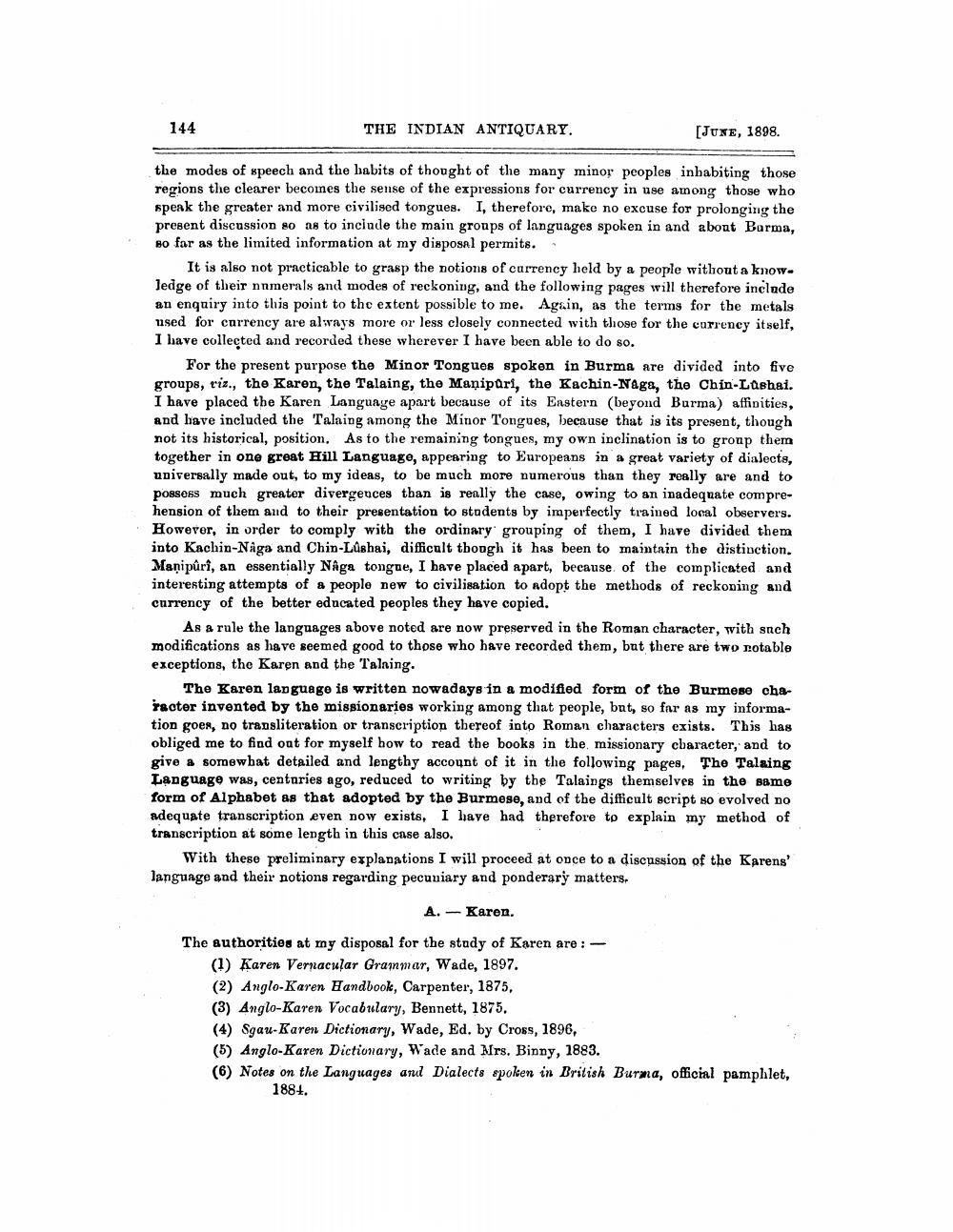________________
144
THE INDIAN ANTIQUARY.
[JUNE, 1898.
the modes of speech and the babits of thought of the many minor peoples inhabiting those regions the clearer becomes the sense of the expressions for currency in use among those who speak the greater and more civilised tongues. I, therefore, make no excuse for prolonging the present discussion so as to include the main groups of languages spoken in and about Barma, Ho far as the limited information at my disposal permits.
It is also not practicable to grasp the notions of currency held by a people without a knowledge of their numerals and modes of reckoning, and the following pages will therefore include an enquiry into this point to the extent possible to me. Again, as the terms for the metals used for currency are always more or less closely connected with those for the currency itself, I have collected and recorded these wherever I have been able to do so.
For the present purpose the Minor Tongues spoken in Burma are divided into five groups, riz., the Karen, the Talaing, the Manipuri, the Kachin-Naga, the Chin-Lashai. I have placed the Karen Language apart because of its Enstern (beyond Burma) affinities, and have included the Talaing among the Minor Tongues, because that is its present, though not its historical, position. As to the remaining tongues, my own inclination is to group them together in one great Hill Language, appearing to Europeans in a great variety of dialects, universally made out, to my ideas, to be much more numerous than they really are and to possess much greater divergences than is really the case, owing to an inadequate comprehension of them and to their presentation to stodents by imperfectly trained local observers. However, in order to comply with the ordinary grouping of them, I have divided them into Kachin-Naga and Chin-Lushai, difficult though it has been to maintain the distinction. Manipûri, an essentially Naga tongae, I have placed apart, because of the complicated and interesting attempts of a people new to civilisation to adopt the methods of reckoning and currency of the better educated peoples they have copied.
As a rule the languages above noted are now preserved in the Roman character, with snch modifications as have seemed good to those who have recorded them, but there are two notable exceptions, the Karen and the Talning.
The Karen language is written nowadays in a modified form of the Burmese character invented by the missionaries working among that people, bat, so far as my information goes, no transliteration or transcription thereof into Roman characters exists. This has obliged me to find out for myself how to read the books in the missionary character, and to give a somewhat detailed and lengthy account of it in the following pages. The Talaing Language was, centuries ago, reduced to writing by the Talaings themselves in the same form of Alphabet as that adopted by the Burmese, and of the difficult script so evolved no adequate transcription even now exists. I have had therefore to explain my method of transcription at some length in this case also.
With these preliminary explanations I will proceed at once to a discussion of the Karens' language and their notions regarding pecuniary and ponderary matters.
A. - Karen.
The authorities at my disposal for the study of Karen are: -
(1) Karen Vernacular Grammar, Wade, 1897. (2) Anglo-Karen Handbook, Carpenter, 1875, (3) Anglo-Karen Vocabulary, Bennett, 1875. (4) Sgau-Karen Dictionary, Wade, Ed. by Cross, 1896, (5) Anglo-Karen Dictionary, Wade and Mrs. Binny, 1883. (6) Notes on the Languages and Dialects spoken in British Burna, official pamphlet,
1884.




